
Ficus is a genus of about 850 species of woody trees, shrubs, vines, epiphytes and hemiepiphytes in the family Moraceae. Collectively known as fig trees or figs, they are native throughout the tropics with a few species extending into the semi-warm temperate zone. The common fig (F. carica) is a temperate species native to southwest Asia and the Mediterranean region, which has been widely cultivated from ancient times for its fruit, also referred to as figs. The fruit of most other species are also edible though they are usually of only local economic importance or eaten as bushfood. However, they are extremely important food resources for wildlife. Figs are also of considerable cultural importance throughout the tropics, both as objects of worship and for their many practical uses.

Fig wasps are wasps of the superfamily Chalcidoidea which spend their larval stage inside figs. Some are pollinators but others simply feed off the plant. The non-pollinators belong to several groups within the superfamily Chalcidoidea, while the pollinators are in the family Agaonidae. While pollinating fig wasps are gall-makers, the remaining types either make their own galls or usurp the galls of other fig wasps; reports of their being parasitoids are considered dubious.

The family Agaonidae is a group of pollinating fig wasps. They spend their larval stage inside the fruits of figs. The pollinating wasps are the mutualistic partners of the fig trees. Extinct forms from the Eocene and Miocene are nearly identical to modern forms, suggesting that the niche has been stable over geologic time.
The Pondoland fig is a species of fig that is endemic to forests of coastal South Africa, where it is threatened by habitat loss.
Ficus verruculosa, the water fig, is a species of fig from sub-saharan Africa.

Ficus sur, with the common names Cape fig and broom cluster fig, is a widespread Afrotropical species of cauliflorous fig.

Ficus craterostoma, a species of strangler fig, is a fig shrub or tree of the Afrotropics that may grow up to 20 m tall. It is found in lowland tropical and swamp forests in the west, or in afromontane forests, including rocky situations, along Africa's eastern escarpments. The western and eastern populations may constitute separate species, as they occur at different altitudes where their ranges meet in central Africa, while they seem to have exclusive pollinating wasp species.

Ficus rubra is a species of flowering plant in the family of Moraceae, native to some islands in the Indian Ocean.
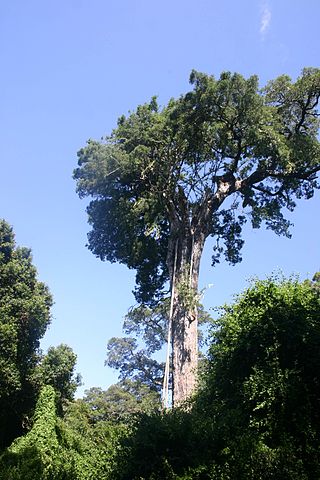
Ficus burtt-davyi is a fig species endemic to Southern Africa, belonging to the Mulberry family of Moraceae. It grows in coastal and inland forests up to 1500m, from the vicinity of Mossel Bay in the Southern Cape to southern Mozambique - the forms growing on coastal dunes in the northern part of its range are salt tolerant and form low thickets on the margins of woodland. In the southern and eastern Cape forests the species becomes a strangler or liane, while when found on rocky outcrops and cliffs it usually develops into a rock-splitter.

Ceratosolen is an Old World wasp genus in the family Agaonidae. They are pollinators of the monoecious fig subsections Sycomorus and Sycocarpus, and the section Neomorphe, all belonging to the subgenus Sycomorus. The genus is native to the Palearctic, Afrotropical, Indomalayan and Australasian realms.

Sycophaga is a mainly Afrotropical gall wasp genus of the superfamily Chalcidoidea that live on the section Sycomorus of the monoecious fig subgenus, Sycomorus, and one of several fig wasp genera to exploit its mutualism with Ceratosolen wasps.

Apocrypta is an Old World genus of parasitic fig wasps in the family Pteromalidae. They are parasitoids of gall-wasps in the Sycophagini tribe, and especially Ceratosolen species, pollinators of the Sycomorus, Sycocarpus and Neomorphe sections of Ficus. They seem to be fig species-specific.
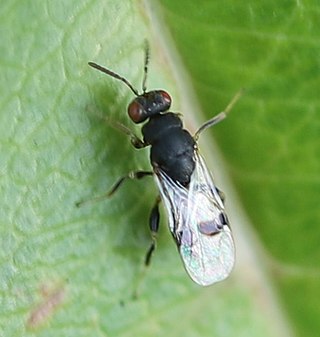
Sycophila is a genus of wasp that associates with figs and galls of various insects such as gall wasps and gall midges. They have a cosmopolitan distribution.

Ficus cordata, the Namaqua rock fig, or Namaqua fig is a species of fig that occurs in two disjunct populations in Africa, one in the arid southwest of the continent, and a second in the northern subtropics. In the south it is often the largest and most prominent tree, and is virtually restricted to cliff faces and rock outcrops, where it has a rock-splitting habit.
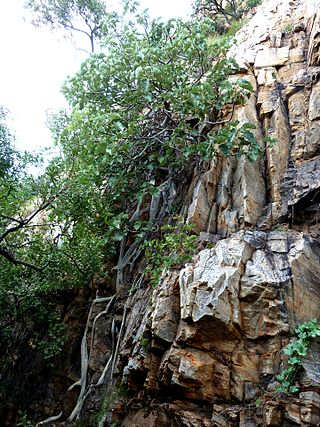
Ficus abutilifolia, the large-leaved rock fig, is a species of African rock-splitting fig that occurs in two disjunct regions, one population north, and another south of the equator. The two populations are pollinated by different fig wasps, and are morphologically distinct. It is named for the similarity of its broadly ovate leaves to that of Abutilon. It is virtually restricted to cliff faces and rock outcrops, and is easily recognized from its large, glabrous leaves and smooth, pale bark.
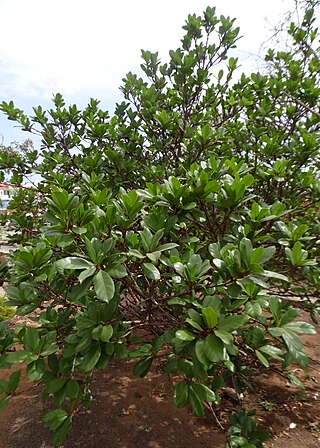
''Ficus cyathistipula'', the African fig tree, is a species of fig that is native to the tropical forest regions of Africa. They may be small trees, shrubs or hemi-epiphytic lianas, and are widespread in the moist tropics, where they may be found in Afromontane or rainforest, often overhanging pools. The figs are reddish when ripe, and have thick, spongy walls that enable them to float on water. They are named for their cup-shaped (cyathus-) and persistent stipules (stipula).
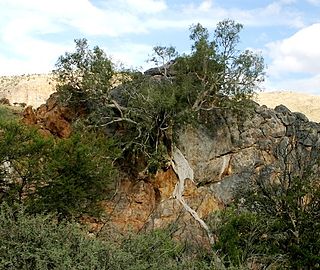
The Laurel fig is a species of rock-splitting fig that is native to the semi-desert regions of southwestern Africa. It is only found on rocks, up to an altitude of 1,300 m (4,300 ft).

Ficus polita, the heart-leaved fig, is a species of fig that is native to forests of tropical Africa,
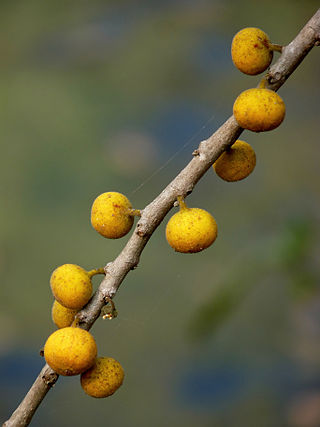
Ficus exasperata, also called the sandpaper tree, forest sandpaper fig, white fig, or sandpaper leaf tree, is a deciduous, and dioecious species of plant in the mulberry family Moraceae, native to tropical Africa and southern Asia.
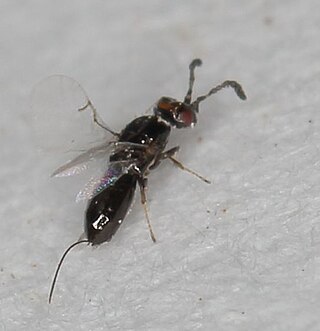
Platyscapa soraria is a species of fig wasp; it is the pollinator of Ficus ingens.

















